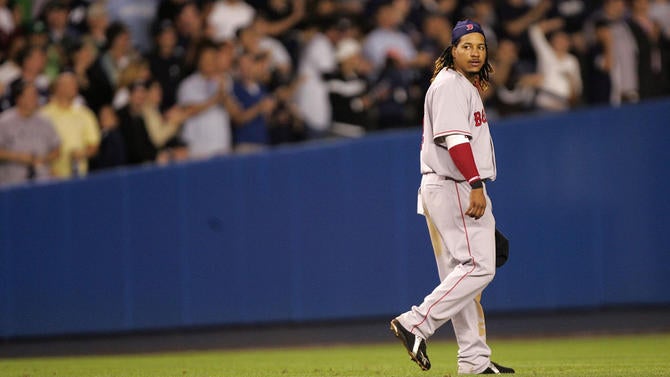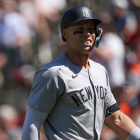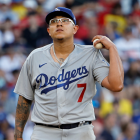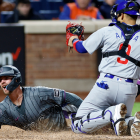Leading up on the announcement of the Baseball Hall of Fame class of 2017 on Jan. 18, we're examining each of the 34 candidates on this year's BBWAA ballot. By way of reminder, a candidate must be named on at least 75 percent of submitted BBWAA ballots in order to be elected into the Hall of Fame.
We've already looked at the numerous candidates who are certain to fall off the ballot after only one year (candidates receiving less than five percent drop off the ballot). Now we're looking at those hopefuls who figure to have meaningful support and perhaps even earn induction at some point. Up this time around is the decorated and controversial slugger Manny Ramirez.
Ramirez spent parts of 19 seasons in MLB, eight apiece with the Indians and Red Sox. Along the way, he authored some tremendous offensive numbers, as we're about to see. With Ramirez, though, it's not just about the numbers. It's also about his history of performance-enhancing drug use, which is likely what will keep him out of the Hall of Fame for the foreseeable future. Now for a closer look ...

The case for Ramirez
This is not especially challenging. Simply put, Ramirez is one of the most productive hitters in baseball history. Across those 19 seasons, he batted .312/.411/.585 (154 OPS+) with 555 homers; 547 doubles; 1,831 RBI; 1,544 runs scored; 4,826 total bases; 1,329 walks; 2,574 hits; 1,122 extra-base hits; and 2,302 games played. Along the way, he made 12 All-Star teams and won nine Silver Sluggers. Suffice it to say, that's a Cooperstown resume on its face.
Need more? Here's a partial listing of where Ramirez ranks all-time in some key indicators ...
- 32nd in offensive WAR;
- 32nd in OBP;
- Eighth in slugging;
- Eight in OPS;
- 28th in OPS+;
- 15th in home runs;
- 31st in doubles;
- 18th in RBI;
- 59th in runs scored;
- 29th in total bases;
- 39th in walks;
- 12th in intentional walks (sign of respect, right there);
- 16th in extra-base hits;
- 63rd in sac flies;
Could we go on? We could go on. For instance, Ramirez also batted .285/.394/.544 in postseason play with 29 homers in 111 career playoff games. That makes him the all-time leader in postseason home runs. So there's that.
Absent tarnish, Ramirez would be not just a Hall of Famer but also a first-ballot, inner-circle Hall of Famer. Alas and alack, he's not without tarnish ...
The case against Ramirez
While many of the otherwise obvious Hall candidates are dinged by circumstantial PED speculation, Ramirez has straight-up failed tests and been disciplined for doing so. In 2009, Ramirez was suspended for 50 games for being prescribed a female fertility drug -- human chorionic gonadotrophin (HCG). HCG can be used as a performance-enhancer, but it's really more of a follow-up protocol. From Scientific American:
The hormone does, however, help male athletes right their chemical balance after the use of other performance enhancers. "Basically, HCG may be used in an attempt to prevent testicular atrophy (shrinkage) that otherwise may occur when using anabolic steroids for prolonged periods," Kicman says. Anabolic steroids are synthetic substances derived from male sex hormones that promote improved endurance and boost muscle mass and strength. "HCG may also be used," he says, "following cessation of prolonged anabolic steroid use, to try to hasten a return to normal testicular function," when the athlete would have very low levels of circulating male hormones.
It's easy to come away with some damning implications from Ramirez's apparent HCG use. That, of course, wasn't all. Just five games into his Rays tenure in 2011, Ramirez was suspended again after testing positive for a banned substance. As a second-time offender, Ramirez was banned for 100 games. Rather than serve his suspension, Ramirez retired. A partial season in Taiwan and minor-league hitches with the Athletics, Rangers, and Cubs followed, but Ramirez never returned to the bigs.
Ramirez later reconstructed his image by admitting to and apologizing for his past PED use, and by all accounts he's been an asset as a minor-league consultant for the Cubs. That said, his two suspensions in tandem with his reported positive test during the 2003 survey testing (no PED policy was in place at the time, and tests were supposed to be anonymous) and ugly end to his Boston tenure certainly raise concerns. That brings us to the BBWAA's stated criteria for evaluating a player's Hall of Fame credentials ...
Voting shall be based upon the player's record, playing ability, integrity, sportsmanship, character, and contributions to the team(s) on which the player played.
You'll note the words "integrity" and "character" therein. Although it's inconsistently applied and far too vague and open-ended, what's become informally known as the "character clause" is a real thing. It's not hard to marshal a case that Ramirez is unqualified on this front. I'd pay zero heed to the clause were I a Hall voter, but others are free to wield it. As well, with Ramirez we have positive tests and a subsequent admission, so the PED case against him is more than circumstantial. That's the only plausible reason for passing over a hitter who would otherwise be an incontrovertible Hall of Famer.
Will he make it?
Not right away. Per Ryan Thibodaux's ballot tracker, Ramirez has been named on 32.8 percent of known ballots. He's obviously not going to make it in this, his first year on the BBWAA ballot, but he's well above the 5.0 percent cutoff line for remaining on the ballot. On the other hand, Ramirez right now is a bit shy of where Roger Clemens and Barry Bonds were on their first ballot. Those two are going to make it in, possibly in 2018, but you can argue that they had a stronger voting foundation than Ramirez because the PED evidence against them was largely circumstantial.
The election of Bud Selig, who as commissioner oversaw the "steroid era" has given many formerly anti-PED voters the rationale they need to vote for admitted or suspected users, and many voters this time around have cited that as motivation for voting for, say, Clemens and Bonds. On those grounds, Ramirez may make up ground. However, he'll need to realize significant gains in his second year on the ballot. Ramirez's best hope is that a number of voters are giving him the "not on the first ballot" treatment and will take a more nuanced look at his candidacy next year. In some ways, Ramirez's early years on the ballot will provide a roadmap for Alex Rodriguez. For now, the most we can say about Ramirez is that he's not going into the Hall of Fame in 2017 despite a statistical resume that demands it.
Other Hall of Fame cases: Posada | Ramirez | Guerrero | Rodriguez | Sosa | Wagner | Sheffield






















